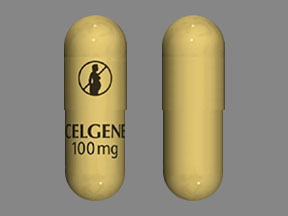Thalidomide Disease Interactions
There are 5 disease interactions with thalidomide.
Thalidomide (applies to thalidomide) seizures
Moderate Potential Hazard, Moderate plausibility.
Seizures, including grand mal convulsions, have been reported during post-approval use of thalidomide in clinical practice. Because these events are reported voluntarily from a population of unknown size, estimates of frequency cannot be made. Most patients had disorders that may have predisposed them to seizure activity, and it is not currently known whether thalidomide has any epileptogenic influence. During therapy with thalidomide, patients with a history of seizures or with other risk factors for the development of seizures should be monitored closely for clinical changes that could precipitate acute seizure activity.
Thalidomide (applies to thalidomide) HIV infection
Moderate Potential Hazard, Moderate plausibility.
In two separate studies involving HIV-seropositive patients, the use of thalidomide was associated with an increase in plasma viral RNA levels. The clinical significance of this finding is unknown. Both studies were published prior to the availability of highly active antiretroviral therapy, or HAART. Until more information is available, the interim recommendation is to measure the viral load after the first and third months of thalidomide treatment and every 3 months thereafter (or as often as indicated by the patient's antiretroviral regimen and clinical status).
Thalidomide (applies to thalidomide) hypotension
Moderate Potential Hazard, Moderate plausibility.
The use of thalidomide has been associated with dizziness and orthostatic hypotension. Therapy with thalidomide should be administered cautiously in patients with preexisting hypotension. Rising slowly from a recumbent position is recommended.
Thalidomide (applies to thalidomide) neutropenia
Moderate Potential Hazard, Moderate plausibility.
The use of thalidomide has been associated with decreased white blood cells counts, including neutropenia. Therapy with thalidomide should be administered cautiously in patients with preexisting neutropenia. Treatment should not be initiated if absolute neutrophil count is below 750/mm3. Monitoring white blood cell count and differential routinely is recommended during treatment.
Thalidomide (applies to thalidomide) peripheral neuropathy
Moderate Potential Hazard, High plausibility.
The use of thalidomide has been associated with the development of peripheral neuropathy, which is sometimes irreversible. Therapy with thalidomide should be administered cautiously in patients with preexisting neuropathy and only after the neuropathy has returned to baseline. Patients should be monitored routinely for early signs of neuropathy including numbness, tingling, pain, or a burning sensation in the hands or feet. If symptoms of drug-induced neuropathy develop, thalidomide should be discontinued immediately.
Switch to professional interaction data
Thalidomide drug interactions
There are 826 drug interactions with thalidomide.
Thalidomide alcohol/food interactions
There is 1 alcohol/food interaction with thalidomide.
More about thalidomide
- thalidomide consumer information
- Check interactions
- Compare alternatives
- Reviews (1)
- Side effects
- Dosage information
- During pregnancy
- Drug class: leprostatics
- Breastfeeding
- En español
Related treatment guides
Drug Interaction Classification
| Highly clinically significant. Avoid combinations; the risk of the interaction outweighs the benefit. | |
| Moderately clinically significant. Usually avoid combinations; use it only under special circumstances. | |
| Minimally clinically significant. Minimize risk; assess risk and consider an alternative drug, take steps to circumvent the interaction risk and/or institute a monitoring plan. | |
| No interaction information available. |
See also:
Further information
Always consult your healthcare provider to ensure the information displayed on this page applies to your personal circumstances.


